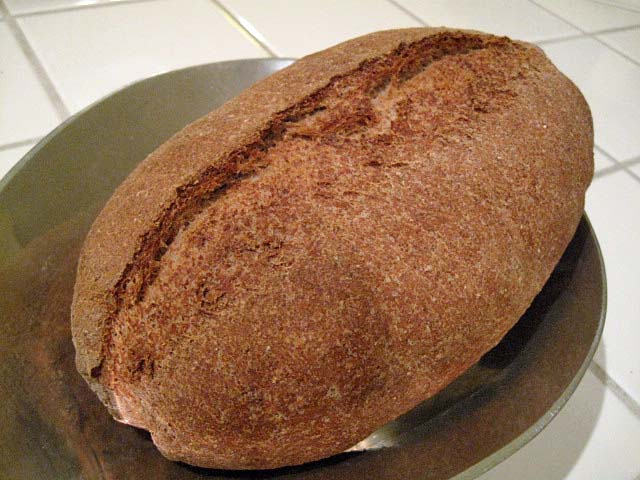100% Whole Wheat Bread from WGB, made with fresh-milled flour

- Log in or register to post comments
- 16 comments
- View post
- dmsnyder's Blog

Made these Kaiser rolls the other day, along with a loaf of whole wheat bread (actually about 50% whole wheat 50% bread flour). The kaiser rolls turned out great, but the loaf I used to test the size of my new clay baker from King Arthur Flour. I discovered that a 2 lb loaf fit's to the point of taking the shape of the baker, luckily I greased both top and bottom of it! The rolls turned out like this and were nice a tender with a good crumb:
Hello, What a pleasure to discover farine-mc's post on her blog about Noah Elbers and his talented group of bakers, and this bread.
Thank you Farine!!! (Farine-mc's post is here: http://www.farine-mc.com/2011/01/noah-elbers-maple-oatmeal-bread.html - great information on how to make this bread, and video from Mr. Elbers' bakery, too!)
This oatmeal bread is made with cooked steel-cut oats, maple syrup, levain and a poolish. I had to try it!:
Following 4 sourdough baking disasters in a row, a planned not to throw the dough this time. I sprinkled 1tsp of yeast and baked it 2 1/2 hours later.
The crumb shot above is from a slice at one side of the loaf, while the the crumb below is from the other side.
I joined in the Dutch Oven craze with a Pain de Campagne bake a few weeks ago, and the outcome was fine, but I think I get my best results with Sylvia’s magic towel technique. So, for my first try at a Tartine-like Country Bread, I baked two sloppy boules on the stone.
I never got around to posting last week, but I did get around to making yet another batch of poolish baguettes. The only real change was to use King Arthur All-Purpose flour in the final dough (making up 2/3 of the total flour with the Bread Flour in the poolish). Also, thinking that my lame was getting dull, I tried scoring with the other side of the blade (switching from "Method 1" to "Method 2" as dmsnyder terms them). I wasn't enturely impressed with the results.
Results: Exterior

There have been a lot of discussion here on TFL regarding covered baking, ranging from covering dough on stone with a roasting pan, to baking in a dutch oven like a no-knead dough, to baking in a "combo-baker" as Tartin Bread Book suggests. I recently got a 2.5 quart oval enamel cast iron pot at a very good price (William Sonoma winter sale is a gold mine!), so I finally can try my hand on covered baking.
It’s been a while since my last post. I didn’t post anything because I was lazy… I did bake, a lot. From bread, flat bread, pizza and more (next blog entry will be on one of them).
Today, I will continue with my sandwich bread. The recipe is not so different from the previous one, but this time I reduced the amount of yeast by half, added more sugar, and changed the ratio of water & milk. Nothing fancy here, but it taste good.
I love sweet basil, and a pesto made out of it is an excellent addition to a lot of dishes.
I make a 60% rye bread, and I use a buttermilk & rye soaker. Hydration is around 65%; remainder of flour is generic bread flour. I knead in a Kitchenaid for about 7-10 minutes total. I also stretch and fold 2-4 times, depending on how lazy I am.
The unbaked dough of the last 2 I've made starts to "rip" after I start to fold it. I doubt I could windowpane it. Is that typical? I know rye is low-gluten, but could I be overkneading it? Seems unlikely, but I'm looking forward to feedback.
Thanks!